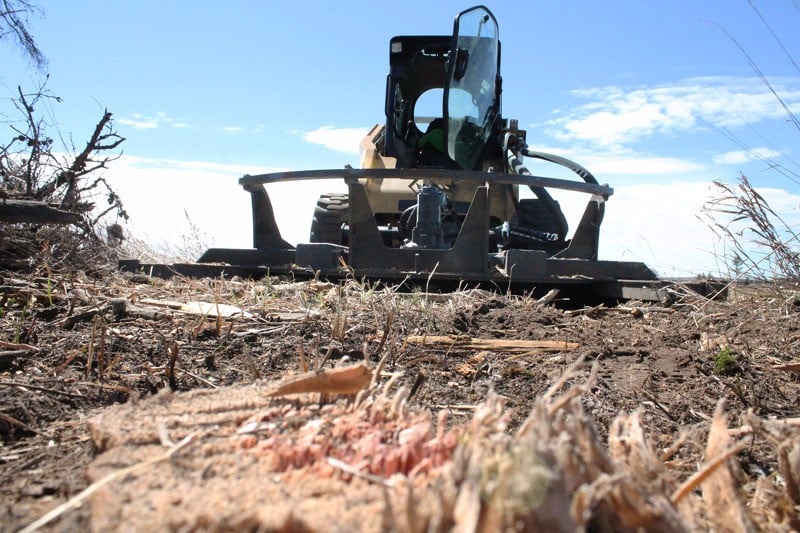A skid steer brush cutter with an open front is a great choice for clearing heavy undergrowth, saplings, dense grass, and weeds.
There are many different brush cutters that make quick work of clearing overgrown brush. Skid steer brush cutters are better suited to tackle large areas of extremely tough and dense brush with minimal impact on the property. They offer superior maneuverability compared to dozers, walk-behind cutters, and pull-behind mowers.
Choosing the best brush cutter for you depends on a number of factors, which we'll cover below. These include understanding the application, having experience, knowing the terrain, and finding a quality cutter that matches your skid steer’s flow rate.
Skid Steer Brush Cutter vs. Skid Steer Brush Hog vs. Skid Steer Brush Mower
When it comes to tools for taking on overgrown brush, it's easy to get swept up in a bit of confusion over what things are called. Are you looking for a brush cutter, brush hog, or brush mower? For some, these terms are used interchangeably. For others, they have different meanings. It can all depend on who you're talking with.
A skid steer brush hog is a rotary mower attachment, and they come in all different sizes. A skid steer brush cutter is also a rotary mower attachment. And a skid steer brush mower? You guessed it. It's a rotary mower attachment.
Here at Virnig Manufacturing, we've named our rotary mower attachments brush cutters, but people often refer to them as brush hogs or brush mowers. We only care that you’re able to get your hands on the right tool for the job and operate it safely and efficiently.
.jpg?width=1280&name=V50-Open-Front-Cutter-Action%20(1).jpg)
3 Considerations for Matching a Cutter to Your Skid Steer
Effective mowing always requires a suitable machine. With so many options to choose from, it’s important to match the brush cutter to the overall skid steer width, the flow rate capabilities of your skid steer’s hydraulic system, and your overall operating capacity.
Cutter Width
A common question is: What attachment width should I purchase? We always tell people to purchase a brush cutter with a cut width that is wider than the tires or tracks of your skid steer. If the cut width does not cover the tracks, then you increase the risk of running over uncut debris; debris that could damage your skid steer tires.
Bigger is not always better. Selecting a brush cutter attachment that is too wide will:
- Increase weight
- Increase overall cutting surface area
- Require more power to run it effectively
And each of these factors directly impacts performance.
Skid Steer Flow Rate
You must know the flow rate of your skid steer and the minimum and maximum flow rate of the brush cutter's motor. Flow rate is typically listed in gallons per minute (GPM).
IMPORTANT TIP: To achieve optimal performance, the brush cutter’s flow rate should fall within the min/max range of the brush cutter motor.
Flow rate examples:
- If you use a Standard Flow brush mower motor in High Flow, the motor will be over-stressed. It may not fail immediately, but irreparable damage has likely occurred and will eventually cause the motor to fail.
- If you use a High Flow brush mower on a Standard Flow skid steer, you won’t get the performance you desire.
Skid Steer Operating Capacity
Another factor to consider is the operating lift capacity of your skid steer loader. Brush cutters generally weigh about 1,000 – 2,000 pounds. Always check the attachment’s recommended loader capacity to make sure your skid steer has the necessary operating capacity to effectively handle the skid steer brush mower.

When and How to Use a Brush Cutter
Open front brush cutters are not like lawnmowers. They have powerful motors, thicker blades, and are primarily used to cut down thick brush, topple small trees, and make stumps disappear.
Brush cutting provides many benefits, which include:
- Limiting future regrowth
- Expanding usable property
- Reducing brush piles, if any
- Preventing wildfires
- Leaving landscapes looking great
Buying a machine that isn’t strong enough to tackle whatever you’re clearing will be a frustrating waste of money.
If you have several acres to clear, an open front cutter on a skid steer is probably suitable. After all, nobody wants to clear four acres of brush with a walk-behind mower.
USE AN Open front brush cutter TO:
- Maintain or create new trails in the woods or around a lake
- Clear large areas for future development
- Cut down many trees in a short amount of time
- Clear weeds along fence lines
- Quickly reclaim neglected backyards
What Can I Expect From a Virnig Cutter?
We give special attention to our brush cutters to ensure that they meet performance expectations, including enhanced safety features. You can be sure you’re getting a high-quality brush cutter when you get yours from Virnig.
Quality Spindle: The spindle is the most expensive and important performance part of a skid steer brush cutter attachment. Choosing a cutter with a thick, high-quality spindle is an absolute must when making a brush cutter purchase. All of Virnig’s open front brush cutter attachments are made with thick, high-quality USA-made spindles.
Hydraulic Pressure Relief Valves: Pressure relief valves protect the motor and the loader’s hydraulic system from pressure spikes. When the blades hit a large stump or rock, the relief valves open and relieve the pressure. This protects seals and other internal components from damage due to excessive pressure. Virnig’s premium drive components include Eaton® motors with relief valves to provide optimum performance and longevity.
Heavy-Duty Flywheel: A heavy-duty flywheel is needed for handling large debris. If it is too light, the brush cutter will bog down and hurt performance. A heavier flywheel will create more inertia and provide a cleaner, more precise cut. Depending on the model, your Virnig flywheel will be between 150 and 550 lbs with a rounded edge to prevent catching on debris and causing damage.
Safety Features: A skid steer brush cutter motor that features hydraulic dynamic braking will safely stop the flywheel in about ten seconds. Without braking the flywheel will keep spinning for several minutes. The brush cutter attachment should also have a safety feature that prevents the cutter’s deck from going above the cab door. This keeps the cutter close to the ground and limits flying debris, which helps protect the operator. All of Virnig’s attachments offer these crucial safety features.
Replaceable Blades: Replaceable blades minimize downtime. Rocks, dirt, and other obstructions will dramatically increase the dulling of the blades. They will eventually need to be replaced. Virnig’s attachments come with replaceable blades so you can easily extend the life of your cutter.
Replaceable Skid Shoes: Similar to the blades above, skid shoes need replacing from time to time as well. Skid shoes increase the mower deck’s wear life and add protection. Skid shoes help the skid steer mower glide over soft, uneven terrain instead of gouging into the ground. Virnig makes maintenance easy by ensuring that ordering and replacing your skid shoes is simple.
Reinforced, Tall Push Bar: If your cutter needs to go through a lot of small trees and thick debris, then a push bar is essential. Without a push bar, the steel on the front deck may quickly deform and affect the brush mower’s performance. Virnig’s open front attachments all come with push bars that will protect your cutter and extend its longevity.
Reinforced Mower Deck: Take a close look at the steel reinforcements on the top of and under the mower deck — it has to be reinforced since it is the support structure for the entire mower. The mower deck should be constructed with thick, high-grade steel and cross members running across the entire length.
Skid Steer Brush Cutter Reviews
Sometimes the best way to evaluate a brush cutter is to see it in action. Watch how one customer used our V50 Open Front Rotary Brush Cutter to clear cedar trees and brush to create new recreational park trails.
Are you in the market for a new brush cutter? Check out what we have to offer.


